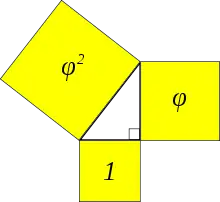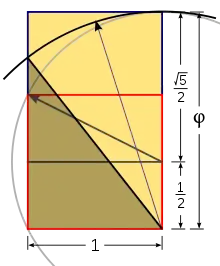Kepler triangle
A Kepler triangle is a right triangle with edge lengths in a geometric progression. The ratio of the progression is √𝜙, where 𝜙 is the golden ratio,[lower-alpha 1] and can be written: , or approximately 1 : 1.272 : 1.618.[1] The squares of the edges of this triangle are also in geometric progression according to the golden ratio itself.

Triangles with such ratios are named after the German mathematician and astronomer Johannes Kepler (1571–1630), who first demonstrated that this triangle is characterised by a ratio between its short side and hypotenuse equal to the golden ratio.[2] Kepler triangles combine two key mathematical concepts—the Pythagorean theorem and the golden ratio—that fascinated Kepler deeply, as he expressed:
Geometry has two great treasures: one is the theorem of Pythagoras, the other the division of a line into extreme and mean ratio. The first we may compare to a mass of gold, the second we may call a precious jewel.[3]
Some sources claim that a triangle with dimensions closely approximating a Kepler triangle can be recognized in the Great Pyramid of Giza,[4][5] making it a golden pyramid.
Derivation
The fact that a triangle with edges , and , forms a right triangle follows directly from rewriting the defining quadratic polynomial for the golden ratio :
into the form of the Pythagorean theorem:
Relation to arithmetic, geometric, and harmonic mean
For positive real numbers a and b, their arithmetic mean, geometric mean, and harmonic mean are the lengths of the sides of a right triangle if and only if that triangle is a Kepler triangle.[6]
Constructing a Kepler triangle

A Kepler triangle can be constructed with only straightedge and compass by first creating a golden rectangle:
- Construct a unit square
- Draw a line from the midpoint of one side of the square to an opposite corner
- Use that line as the radius to draw an arc that defines the height of the rectangle
- Complete the golden rectangle
- Use the longer side of the golden rectangle to draw an arc that intersects the opposite side of the rectangle and defines the hypotenuse of the Kepler triangle
Kepler constructed it differently. In a letter to his former professor Michael Mästlin, he wrote, "If on a line which is divided in extreme and mean ratio one constructs a right angled triangle, such that the right angle is on the perpendicular put at the section point, then the smaller leg will equal the larger segment of the divided line."[2]
A mathematical coincidence

In the Kepler triangle with sides consider:
- the circle that circumscribes it, and
- a square with side equal to the middle-sized edge of the triangle.
Then the perimeters of the square () and the circle () coincide up to an error less than 0.1%.
This is the mathematical coincidence . The square and the circle cannot have exactly the same perimeter, because in that case one would be able to solve the classical (impossible) problem of the quadrature of the circle. In other words, because is a transcendental number.
According to some sources, Kepler triangles appear in the design of Egyptian pyramids. The diagonal of the floor of the King's Chamber, plus the width of the chamber, divided by the length of the chamber is very close to the golden ratio.[5][7] However, according to various scholars who have investigated this relationship, the ancient Egyptians probably did not know the mathematical coincidence involving the number and the golden ratio .[8]
See also
- Golden triangle
- Special right triangles
References
Footnotes
Citations
- Roger Herz-Fischler (2000). The Shape of the Great Pyramid. Wilfrid Laurier University Press. p. 81. ISBN 0-88920-324-5.
- Livio, Mario (2002). The Golden Ratio: The Story of Phi, The World's Most Astonishing Number. New York: Broadway Books. p. 149. ISBN 0-7679-0815-5.
- Karl Fink; Wooster Woodruff Beman; David Eugene Smith (1903). A Brief History of Mathematics: An Authorized Translation of Dr. Karl Fink's Geschichte der Elementar-Mathematik (2nd ed.). Chicago: Open Court Publishing Co. p. 223.
- The Best of Astraea: 17 Articles on Science, History and Philosophy. Astrea Web Radio. 2006. p. 93. ISBN 1-4259-7040-0.
- Squaring the circle, Paul Calter
- Di Domenico, Angelo, "The golden ratio—the right triangle—and the arithmetic, geometric, and harmonic means," The Mathematical Gazette 89, 2005.
- The Great Pyramid, The Great Discovery, and The Great Coincidence, Mark Herkommer, June 24, 2008 (Web archive)
- Markowsky, George (January 1992). "Misconceptions about the Golden Ratio" (PDF). College Mathematics Journal. Mathematical Association of America. 23 (1): 2–19. doi:10.2307/2686193. JSTOR 2686193.
It does not appear that the Egyptians even knew of the existence of φ much less incorporated it in their buildings
External links
| Wikimedia Commons has media related to Kepler triangle. |

